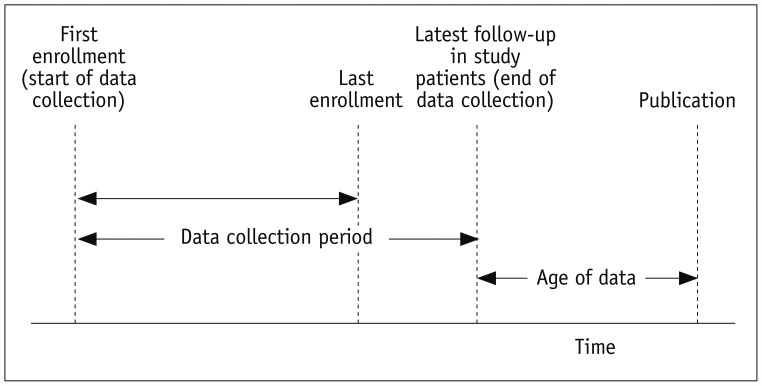2. Ahn S, Park SH, Lee KH. How to demonstrate similarity by using noninferiority and equivalence statistical testing in radiology research. Radiology. 2013; 267:328–338. PMID:
23610094.

3. Lee JG, Jun S, Cho YW, Lee H, Kim GB, Seo JB, et al. Deep Learning in medical imaging: general overview. Korean J Radiol. 2017; 18:570–584. PMID:
28670152.

4. Park SH, Han K. Methodologic guide for evaluating clinical performance and effect of artificial intelligence technology for medical diagnosis and prediction. Radiology. 2018; 286:800–809. PMID:
29309734.
5. Park SH, Kressel HY. Connecting technological innovation in artificial intelligence to real-world medical practice through rigorous clinical validation: what peer-reviewed medical journals could do. J Korean Med Sci. 2018; 33:e152. PMID:
29805337.

6. Kim GB, Lee S, Kim H, Yang DH, Kim YH, Kyung YS, et al. Three-dimensional printing: basic principles and applications in medicine and radiology. Korean J Radiol. 2016; 17:182–197. PMID:
26957903.

7. Kim M, Kim HS. Emerging techniques in brain tumor imaging: what radiologists need to know. Korean J Radiol. 2016; 17:598–619. PMID:
27587949.

8. Welsh J, Lu Y, Dhruva SS, Bikdeli B, Desai NR, Benchetrit L, et al. Age of data at the time of publication of contemporary clinical trials. JAMA Network Open. 2018; 1:e181065.

9. Ahn SJ, Lee JM, Chang W, Lee SM, Kang HJ, Yang H, et al. Prospective validation of intra- and interobserver reproducibility of a new point shear wave elastographic technique for assessing liver stiffness in patients with chronic liver disease. Korean J Radiol. 2017; 18:926–935. PMID:
29089825.

10. Aslaner R, Pekcevik Y, Sahin H, Toka O. Variations in the origin of inferior phrenic arteries and their relationship to celiac axis variations on CT angiography. Korean J Radiol. 2017; 18:336–344. PMID:
28246513.

11. Azad R, Tayal M, Azad S, Sharma G, Srivastava RK. Qualitative and quantitative comparison of contrast-enhanced fluid-attenuated inversion recovery, magnetization transfer spin echo, and fat-saturation T1-weighted sequences in infectious meningitis. Korean J Radiol. 2017; 18:973–982. PMID:
29089830.

12. Bae YJ, Choi BS, Jung C, Yoon YH, Sunwoo L, Bae HJ, et al. Differentiation of deep subcortical infarction using high-resolution vessel wall MR imaging of middle cerebral artery. Korean J Radiol. 2017; 18:964–972. PMID:
29089829.

13. Bae YJ, Choi BS, Lee KM, Yoon YH, Sunwoo L, Jung C, et al. Efficacy of maximum intensity projection of contrast-enhanced 3D turbo-spin echo imaging with improved motion-sensitized driven-equilibrium preparation in the detection of brain metastases. Korean J Radiol. 2017; 18:699–709. PMID:
28670165.

14. Becker AS, Perucho JA, Wurnig MC, Boss A, Ghafoor S, Khong PL, et al. Assessment of cervical cancer with a parameter-free intravoxel incoherent motion imaging algorithm. Korean J Radiol. 2017; 18:510–518. PMID:
28458603.

15. Chae HD, Lee JY, Jang JY, Chang JH, Kang J, Kang MJ, et al. Photoacoustic imaging for differential diagnosis of benign polyps versus malignant polyps of the gallbladder: a preliminary study. Korean J Radiol. 2017; 18:821–827. PMID:
28860899.

16. Chan WY, Chong LR. Anatomical variants of lister's tubercle: a new morphological classification based on magnetic resonance imaging. Korean J Radiol. 2017; 18:957–963. PMID:
29089828.

17. Chen SQ, Huang M, Shen YY, Liu CL, Xu CX. Abbreviated MRI protocols for detecting breast cancer in women with dense breasts. Korean J Radiol. 2017; 18:470–475. PMID:
28458599.

18. Cheng Y, Huang LX, Zhang L, Ma M, Xie SS, Ji Q, et al. Longitudinal intrinsic brain activity changes in cirrhotic patients before and one month after liver transplantation. Korean J Radiol. 2017; 18:370–377. PMID:
28246517.

19. Choi IY, Park SH, Park SH, Yu CS, Yoon YS, Lee JL, et al. CT enterography for surveillance of anastomotic recurrence within 12 months of bowel resection in patients with Crohn's disease: an observational study using an 8-year registry. Korean J Radiol. 2017; 18:906–914. PMID:
29089823.

20. Choi TW, Lee JM, Lee DH, Lee JH, Yu SJ, Kim YJ, et al. Percutaneous dual-wwitching monopolar radiofrequency ablation using a separable clustered electrode: a preliminary study. Korean J Radiol. 2017; 18:799–808. PMID:
28860897.
21. Chung HW, Ko SM, Hwang HK, So Y, Yi JG, Lee EJ. Diagnostic performance of coronary CT angiography, stress dual-energy CT perfusion, and stress perfusion single-photon emission computed tomography for coronary artery disease: comparison with combined invasive coronary angiography and stress perfusion cardiac MRI. Korean J Radiol. 2017; 18:476–486. PMID:
28458600.

22. Feng R, Tong J, Liu X, Zhao Y, Zhang L. High-pitch coronary CT angiography at 70 kVp adopting a protocol of low injection speed and low volume of contrast medium. Korean J Radiol. 2017; 18:763–772. PMID:
28860894.

23. Goo HW, Allmendinger T. Combined electrocardiography- and respiratory-triggered CT of the lung to reduce respiratory misregistration artifacts between imaging slabs in free-breathing children: initial experience. Korean J Radiol. 2017; 18:860–866. PMID:
28860904.

24. Huh J, Kim KJ, Park SH, Park SH, Yang SK, Ye BD, et al. Diffusion-weighted MR enterography to monitor bowel inflammation after medical therapy in Crohn's disease: a prospective longitudinal study. Korean J Radiol. 2017; 18:162–172. PMID:
28096726.

25. Hwang JS, Lee H, Lee B, Lee SJ, Jou SS, Lim HK, et al. Estimation of diastolic filling pressure with cardiac CT in comparison with echocardiography using tissue Doppler imaging: determination of optimal CT reconstruction parameters. Korean J Radiol. 2017; 18:632–642. PMID:
28670158.

26. Hyun D, Park KB, Cho SK, Park HS, Shin SW, Choo SW, et al. Portal vein stenting for delayed jejunal varix bleeding associated with portal venous occlusion after hepatobiliary and pancreatic surgery. Korean J Radiol. 2017; 18:828–834. PMID:
28860900.

27. Jang J, Kim TW, Hwang EJ, Choi HS, Koo J, Shin YS, et al. Assessment of arterial wall enhancement for differentiation of parent artery disease from small artery disease: comparison between histogram analysis and visual analysis on 3-dimensional contrast-enhanced T1-weighted turbo spin echo MR images at 3T. Korean J Radiol. 2017; 18:383–391. PMID:
28246519.

28. Jeon TY, Kim JH, Lee J, Yoo SY, Hwang SM, Lee M. Value of repeat brain MRI in children with focal epilepsy and negative findings on initial MRI. Korean J Radiol. 2017; 18:729–738. PMID:
28670168.

29. Kang EJ, Lee KN, Choi WJ, Kim YD, Shin KM, Lim JK, et al. Left ventricular functional parameters and geometric patterns in Korean adults on coronary CT angiography with a 320-detector-row CT scanner. Korean J Radiol. 2017; 18:664–673. PMID:
28670161.

30. Kang TW, Lee MW, Song KD, Kim M, Kim SS, Kim SH, et al. Added value of contrast-enhanced ultrasound on biopsies of focal hepatic lesions invisible on fusion imaging guidance. Korean J Radiol. 2017; 18:152–161. PMID:
28096725.

31. Kang Y, Lee GY, Lee JW, Lee E, Kim B, Kim SJ, et al. Texture analysis of torn rotator cuff on preoperative magnetic resonance arthrography as a predictor of postoperative tendon status. Korean J Radiol. 2017; 18:691–698. PMID:
28670164.

32. Kim B, Yoon DY, Seo YL, Park MW, Kwon KH, Rho YS, et al. Value of the post-operative CT in predicting delayed flap failures following head and neck cancer surgery. Korean J Radiol. 2017; 18:536–542. PMID:
28458606.

33. Kim DJ, Park MK, Jung DE, Kang JH, Kim BM. Radiation dose reduction without compromise to image quality by alterations of filtration and focal spot size in cerebral angiography. Korean J Radiol. 2017; 18:722–728. PMID:
28670167.

34. Kim GE, Shin SS, Kim JW, Heo SH, Lim HS, Jun CH, et al. Incidental, small (< 3 cm), unilocular, pancreatic cysts: factors that predict lesion progression during imaging surveillance. Korean J Radiol. 2017; 18:915–925. PMID:
29089824.
35. Kim HJ, Bang JI, Kim JY, Moon JH, So Y, Lee WW. Novel application of quantitative single-photon emission computed tomography/computed tomography to predict early response to methimazole in Graves' disease. Korean J Radiol. 2017; 18:543–550. PMID:
28458607.

36. Kim JS, Kim HJ, Hong SM, Park SH, Lee JS, Kim AY, et al. Post-ischemic bowel stricture: CT features in eight cases. Korean J Radiol. 2017; 18:936–945. PMID:
29089826.

37. Kim SK, Lee KA, Sauk S, Korenblat K. Comparison of transjugular intrahepatic portosystemic shunt with covered stent and balloon-occluded retrograde transvenous obliteration in managing isolated gastric varices. Korean J Radiol. 2017; 18:345–354. PMID:
28246514.

38. Kim SS, Jin GY, Li YZ, Lee JE, Shin HS. CT quantification of lungs and airways in normal Korean subjects. Korean J Radiol. 2017; 18:739–748. PMID:
28670169.

39. Kim YJ, Lee EH, Jun JK, Shin DR, Park YM, Kim HW, et al. Analysis of participant factors that affect the diagnostic performance of screening mammography: a report of the alliance for breast cancer screening in Korea. Korean J Radiol. 2017; 18:624–631. PMID:
28670157.

40. Kim YP, Haam SJ, Lee S, Lee GD, Joo SM, Yum TJ, et al. Effectiveness of ambulatory tru-close thoracic vent for the outpatient management of pneumothorax: a prospective pilot study. Korean J Radiol. 2017; 18:519–525. PMID:
28458604.

41. Lee GM, Kim YR, Ryu JH, Kim TH, Cho EY, Lee YH, et al. Quantitative measurement of hepatic fibrosis with gadoxetic acid-enhanced magnetic resonance imaging in patients with chronic hepatitis B infection: a comparative study on aspartate aminotransferase to Platelet Ratio Index and Fibrosis-4 Index. Korean J Radiol. 2017; 18:444–451. PMID:
28458596.

42. Lee JS, Kim SH, Im SA, Kim MA, Han JK. Human epidermal growth factor receptor 2 expression in unresectable gastric cancers: relationship with CT characteristics. Korean J Radiol. 2017; 18:809–820. PMID:
28860898.

43. Lee JW, Jeong YJ, Lee G, Lee NK, Lee HW, Kim JY, et al. Predictive value of cardiac magnetic resonance imaging-derived myocardial strain for poor outcomes in patients with acute myocarditis. Korean J Radiol. 2017; 18:643–654. PMID:
28670159.

44. Lee MS, Moon MH, Woo H, Sung CK, Jeon HW, Lee TS. Ruptured corpus luteal cyst: prediction of clinical outcomes with CT. Korean J Radiol. 2017; 18:607–614. PMID:
28670155.

45. Min ZG, Niu C, Zhang QL, Zhang M, Qian YC. Optimal factors of diffusion tensor imaging predicting corticospinal tract injury in patients with brain tumors. Korean J Radiol. 2017; 18:844–851. PMID:
28860902.

46. Nam HY, Jun S, Pak K, Kim IJ. Concurrent low brain and high liver uptake on FDG PET are associated with cardiovascular risk factors. Korean J Radiol. 2017; 18:392–401. PMID:
28246520.

47. Park HJ, Kim HJ, Park SH, Lee JS, Kim AY, Ha HK. Gastrointestinal involvement of recurrent renal cell carcinoma: CT findings and clinicopathologic features. Korean J Radiol. 2017; 18:452–460. PMID:
28458597.

48. Park JE, Park B, Kim SJ, Kim HS, Choi CG, Jung SC, et al. Improved diagnostic accuracy of Alzheimer's disease by combining regional cortical thickness and default mode network functional connectivity: validated in the Alzheimer's disease neuroimaging initiative set. Korean J Radiol. 2017; 18:983–991. PMID:
29089831.

49. Seo M, Ryu JK, Jahng GH, Sohn YM, Rhee SJ, Oh JH, et al. Estimation of T2* relaxation time of breast cancer: correlation with clinical, imaging and pathological features. Korean J Radiol. 2017; 18:238–248. PMID:
28096732.

50. Sung J, Jee WH, Jung JY, Jang J, Kim JS, Kim YH, et al. Diagnosis of nerve root compromise of the lumbar spine: evaluation of the performance of three-dimensional isotropic T2-weighted turbo spin-echo SPACE sequence at 3T. Korean J Radiol. 2017; 18:249–259. PMID:
28096733.

51. Tan Y, Zhou J, Zhou Y, Yang X, Yang J, Chen Y. Characteristics detected on computed tomography angiography predict coronary artery plaque progression in non-culprit lesions. Korean J Radiol. 2017; 18:487–497. PMID:
28458601.

52. Tang YL, Zhang XM, Yang ZG, Huang YC, Chen TW, Chen YL, et al. The blood oxygenation T
2* values of resectable esophageal squamous cell carcinomas as measured by 3T magnetic resonance imaging: association with tumor stage. Korean J Radiol. 2017; 18:674–681. PMID:
28670162.
53. Xie S, Li Q, Cheng Y, Zhang Y, Zhuo Z, Zhao G, et al. Impact of liver fibrosis and fatty liver on T1rho measurements: a prospective study. Korean J Radiol. 2017; 18:898–905. PMID:
29089822.

54. Yang SY, Lee KS, Cha MJ, Kim TJ, Kim TS, Yoon HJ. Chest CT features of cystic fibrosis in Korea: comparison with non-cystic fibrosis diseases. Korean J Radiol. 2017; 18:260–267. PMID:
28096734.

55. Yoo H, Lee JM, Yoon JH, Kang HJ, Lee SM, Yang HK, et al. T2* mapping from multi-echo dixon sequence on gadoxetic acid-enhanced magnetic resonance imaging for the hepatic fat quantification: can It be used for hepatic function assessment? Korean J Radiol. 2017; 18:682–690. PMID:
28670163.

56. Yu M, Li Y, Li W, Lu Z, Wei M, Zhang J. Calcification remodeling index characterized by Cardiac CT as a novel parameter to predict the use of rotational atherectomy for coronary intervention of lesions with moderate to severe calcification. Korean J Radiol. 2017; 18:753–762. PMID:
28860893.

57. Yu M, Zhang Y, Li Y, Li M, Li W, Zhang J. Assessment of myocardial bridge by cardiac CT: intracoronary transluminal attenuation gradient derived from diastolic phase predicts systolic compression. Korean J Radiol. 2017; 18:655–663. PMID:
28670160.

58. Zhang Y, Huang QH, Fang Y, Yang P, Xu Y, Hong B, et al. A novel flow diverter (tubridge) for the treatment of recurrent aneurysms: a single-center experience. Korean J Radiol. 2017; 18:852–859. PMID:
28860903.

59. Choi YJ, Chung MS, Koo HJ, Park JE, Yoon HM, Park SH. Does the reporting quality of diagnostic test accuracy studies, as defined by STARD 2015, affect citation? Korean J Radiol. 2016; 17:706–714. PMID:
27587959.

60. Park JE, Han K, Sung YS, Chung MS, Koo HJ, Yoon HM, et al. Selection and reporting of statistical methods to assess reliability of a diagnostic test: conformity to recommended methods in a peer-reviewed journal. Korean J Radiol. 2017; 18:888–897. PMID:
29089821.







 PDF
PDF ePub
ePub Citation
Citation Print
Print




 XML Download
XML Download